
AED-20

Grain Temperature and Moisture Migration Aerate for Temperature Control Aeration Flow Rates Cooling Grain for Winter Storage Observation and Management of Stored Grain Warming Grain in the Spring Summer Management Other Aeration Tips Aeration Costs Peaking Grain in Storage Managing Fines in Storage Temperature Sensing Insect Control in Stored Grain Preventive Insect Control Controlling Infestation Safety Practices Safety Precautions Observations and Actions in Managing Dry Stored Grain
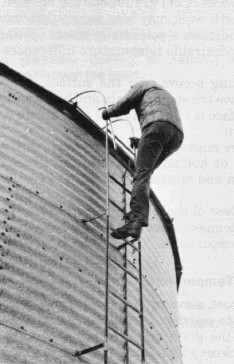
This publication can help you maintain the dollar value of a bin of dry grain. Although storage problems commonly occur during the bad harvest year, many also result from poor dry-grain management practices. Proper use of aeration and insect control, along with an adequate observation program minimize these dry grain problems.
Human safety around flowing and stored grain is included. Neither the design and selection of a system nor grain drying practices are included.
If grain has been dried correctly for the storage period intended, problems with grain condition usually result from:
Each of these problems can be minimized with good management.
See Table 1 for safe grain moisture contents for storage. Reduce the moisture 1% below table values for poor quality grain resulting from drought, frost, blight, harvest damage, etc.
Values for good quality, clean grain and aerated storage: reduce 1% for poor quality grain, such as grain damaged by blight, drought. etc.
Maximum moisture content Grain type & storage time for safe storage, % ---------------------------------------------------- Shelled corn and sorghum Sold as #2 grain by spring 15 1/2 Stored 6-12 mo 14 Stored more than 1 yr 13 Soybeans Sold by spring 14 Stored up to 1 yr 12 Stored more than 1 yr 11 Wheat, oats, barley Stored up to 6 mo 14 Stored more than 6 mo 13 Sunflower Stored up to 6 mo 10 Stored more than 6 mo 8 Flaxseed Stored up to 6 mo 9 Stored more than 6 mo 7 Edible beans Stored up to 6 mo 16 Stored more than 6 mo 14 -----------------------------------------------------
More dried grain goes out of condition because grain temperatures are not controlled than for any other reason. Improper control of temperature causes moisture to move or migrate from one part of the grain mass to another, where the moisture can accumulate and cause grain spoilage problems.
Although moisture migration problems can occur any time grain temperatures vary considerably in different parts of the bin, the most critical time occurs when warm grain is stored into cold winter temperatures. Grain is typically put into storage when the grain temperature is 50-80 F, and perhaps higher.
A bin of grain has 30%-60% air space within the grain mass, and this air surrounding the grain is at the same temperature as the grain.
By late fall or early winter, average outside temperatures fall to 20 F and colder in the Corn Belt, This drop in temperature causes the grain and air near the bin walls to cool. Because grain has fairly good insulating qualities, most of the large center mass of grain and air in the bin remains at about the same temperature as it was when placed in storage.
These temperature differences create a slow movement of both moisture and air. This natural air circulation is called convection currents.
Convection currents develop because the grain and air near the bin walls cool. Cooling causes the air to become heavier and settle toward the bin floor. As the air moves toward the floor and then into the center of the bin, it becomes warmer and less dense or lighter. This causes the air to rise through the warm grain where it continues to increase in temperature. As the air increases in temperature, its moisture-holding capacity increases and it begins to absorb small amounts of moisture.
The slowly moving air rises into the cooler grain mass in the upper portion of the bin where the air is cooled. Some of the moisture in the air is deposited in the grain by both moisture condensation onto the cold grain surfaces and by moisture diffusion into the cooler grain.
Fig 1 shows this natural movement of air and moisture, called moisture migration, which is the most common cause of problems in stored grain.
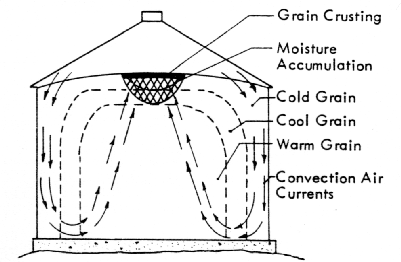
Often, minor moisture migration problems can result in severe spoilage. Check grain often for signs of moisture migration. Look for crusting, wet, slimy grain, ice or frost accumulation, and/or heating. Check for condensation or frost on the underside of roof surfaces, hatches, and vents on cold, crisp days before the sun warms the roof. This almost always indicates moisture migration and often indicates poor grain condition.
Increased moisture content and crusting usually occur at the top center of the grain surface, but can occur anywhere. Cold grain near the bin wall, often the cold north wall, may also accumulate moisture. Crusting indicates a potentially severe spoilage process and undesirable temperature differences in the grain.
If crusting occurs, stir the surface. In extreme cases, remove the spoiled grain and begin aerating. If the top surface is allowed to seal over, severe spoilage is imminent.
Moisture migration can occur in cold grain stored into warm or hot months. Aerate in the spring to warm grain and minimize moisture migration problems.
Regardless of the time of year it is best to maintain grain temperatures within 15-20 F of the average monthly temperature.
In the past, elevator operators turned grain from bin to bin to equalize temperatures, cool the grain and blend the grain mass. Although turning effectively interferes with natural moisture migration and breaks up hot spots, turning requires an empty bin, time and labor. It also tends to damage more grain.
Modern grain management uses aeration to control grain temperature. Aeration forces air through the grain either continuously or intermittently. Aeration is not drying although small moisture changes do occur with a change in temperature. Aeration may be used to maintain quality in wet grain and to cool hot grain from a dryer, but these practices require special procedures that are not discussed in this publication.
Aerate to cool stored grain in the fall so there is no warm grain mass in the center of the storage. Aerate to warm the grain in the spring if storage is to be continued into the hot summer months.
Fig 2 shows how grain is tempered (cooled or warmed) by either negative or positive pressure aeration systems With either system, a tempering (cooling or warming) zone moves through the grain.
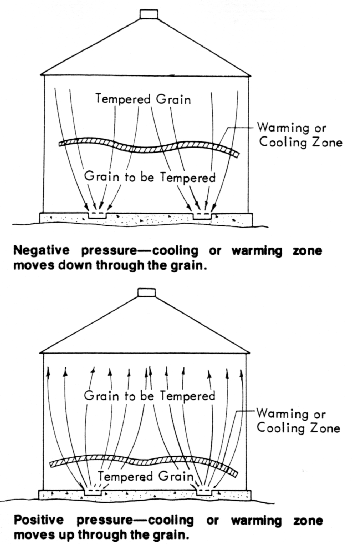
Grain behind the zone of cooling or warming has been tempered. Grain in the zone is changing and approaching outside air conditions. Grain in front of the zone has changed very little. One temperature change or cycle is the time needed to move the tempering zone completely through the stored grain mass.
The tempering zone starts at the top of the grain in a negative pressure or suction type aeration system and moves down. The last grain to cool or warm is normally next to the floor.
In a positive pressure system, the tempering zone starts at the bottom of the bin and moves up. The grain at the top is normally the last to cool or warm.
The movement of the tempering zone completely through the grain is one cooling or warming cycle. Once a cycle bas been started, operate the fan continuously until the zone moves completely through the grain. The time required to complete each cycle depends almost entirely on the aeration airflow rate, as shown in Table 2.
Times are based on 60-lb bushels in the Midwest and 10-15 degree temperature changes.
Airflow Fall Winter Spring
rate cooling cooling warming
cfm/bu hours hours hours
---------------------------------------
1/20 300 400 240
1/10 150 200 120
1/5 75 100 60
1/4 60 80 48
1/3 45 61 36
1/2 30 40 24
3/4 20 27 16
1 15 20 12
1 1/4 12 16 10
1 1/2 10 13 8
---------------------------------------
Grain drying or rewetting is usually insignificant during grain aeration. Because the cooling (or warming) front moves through the grain about 50 times faster than a drying or wetting front, only a small fraction of the grain is rewetted during an aeration cycle, even with high humidities. As a precaution, operate the aeration fan only long enough to accomplish the grain cooling or warming cycle. This is particularly important with higher capacity aeration fans.
Although round bins are shown in all of the figures in this publication, the basic storage and aeration principles are the same for flat grain storage.
Successful aeration rates for farm-type storage usually range from 1/20 cfm/bushel (cfm = cubic feet of air per minute) to over 1 cfm/bushel in bins equipped for rapid grain cooling or drying. About 1/10 cfm/bushel is most common in farm bins, with higher rates more often selected for new bins. The aeration rate for a particular bin depends on the type of bin, air distribution system, desired storage moisture content, and the management procedures to be practiced.
The time for one cooling or warming cycle to completely pass through grain depends on the aeration rate (cfm/bushel) and the time of the year. The number of hours is estimated by:
15
Hours = ------
cfm/bu (fall)
20
Hours = -------
cfm/bu (winter)
12
Hours = --------
cfm/bu (spring)
Example: During the fall, 1/10 cfm (bushel moves one cooling cycle through the grain in approximately 150 hours, or about 6 1/4 days (150/24), or
15
---------- = 150 hours
1/10 cfm/bu
The hours for several aeration rates have been calculated for you in Table 2.
Usually two or three cooling cycles are needed to cool or warm the grain to the desired storage temperatures.
Aerate grain to cool to 35-40 F for winter storage in most of the Midwest. In the northern parts of the Midwest (South Dakota, North Dakota, Minnesota, and Wisconsin), cool stored grain to below 35 F because of colder average winter temperatures.
Start an aeration cycle when the average daily temperature, (high day temperature + low night temperature) / 2, is 10-15 F cooler than the grain. For example, if the high and low daily temperatures are 68 and 56 F, respectively, the average temperature is 62 F. For this example, if grain temperature is above 72 F, start the aeration cycle. Grain from a high temperature dryer is usually 10 F or more above air temperature, so start the aeration cycle immediately.
Operate aeration fans long enough to cool all grain or spoilage may occur. Table 2 estimates 150 hr. (nearly a week) are needed for each cycle to cool grain in the fall assuming a fan capacity of 1/10 a cfm/bu. However, about 2 weeks after the cycle is completed, outside temperatures will have dropped another 10-15 E Repeat the aeration cycle. A maximum of three cooling cycles are needed to properly cool grain for winter storage. Fig 3 shows how outside temperatures and grain temperatures typically lower during the fall with three 1/10 cfm/bu aeration cycles, totaling possibly 500 hr of fan operation (150 hr + 150 hr + 200 hr).
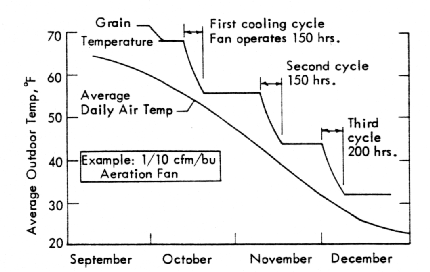
The number and length of cooling cycles depend on fan capacity, when and at what temperature grain was binned, and how fast average air temperatures cool during the fall. For example, 1 cfm/bu cools 10 times faster than 1An cfm/bu and requires only 15 hr for one cycle.
Some operators prefer only two cooling cycles to conserve energy. Cool grain to 50-60 F in the first cycle. Delay the second aeration cycle until outside temperatures will cool grain to 35-40 F.
With low airflow rates (less than 1/5 cfm/bu), you can largely ignore outdoor humidity. Cooling the grain is important. Keep the fan running even if outdoor air has high humidity for a day or two. Any rewetting during these wet periods helps offset the unwanted drying during previous good weather periods. Many operators with airflow rates of 1/10th cfm/bu operate the fan continuously from the time the initial fill is placed in the bin at harvest, until outside air temperatures of 35-40 F have prevailed for at least 1-2 weeks. With higher airflow rates (more than 1/4 cfm/bu), each cooling cycle is short enough that aeration can be delayed a day or two to avoid warm, high humidity air conditions. But if there are any signs of heating or hot spots, no matter what the season or the weather, run the fan continuously until no heating can be detected.
Be sure to continue each aeration cycle until the cooling front has moved completely through the grain. This minimizes the chances for a moisture front within the grain mass that can cause spoilage.
You need to know how fast your aeration fan will move a cooling or warming cycle through a bin. If you don't know the aeration rate (cfm/bu), contact the dealer who furnished the fan.
To be sure the cooling or warming front has passed through the grain, check the grain or air temperature, Fig 4. On a negative pressure (suction) aeration system, check the temperature at the fan discharge. With positive pressure systems, where air is blown up through grain, check grain temperatures by placing a thermometer about 6"-12" into the grain. A sudden change in temperature indicates that the cooling or warming front has passed through the grain. The temperature will be about the average outdoor temperature when the aeration cycle was started.
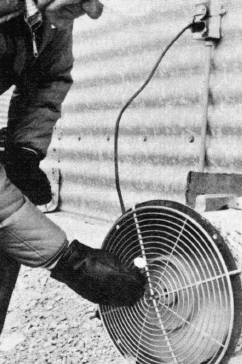
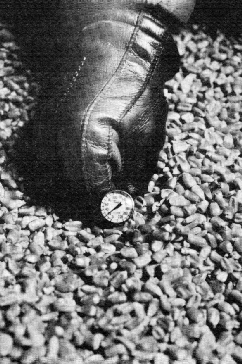
Fig 4. Thermometer locations to monitor progress of aeration cycles.
Be aware that a thermometer in the airstream provides an average temperature. Air passes around pockets of fines and may not totally reflect temperature differences. Also, the tempering zone may not have completely passed through grain near the center if grain is peaked or contains more fines.
Making sure all grain has cooled is especially important during the last aeration cycle. With a suction system, unload some of the grain and check the temperature of the first few gallons to check the bottom grain. Check the next few gallons to check the critical center mass. If any temperatures are higher than the air temperature, run the aeration fan until all grain is cooled.
On pressure systems, check grain temperatures 6"-12" into the upper surface in several locations to confirm when the cooling or warming zone has passed through the grain.
Air does not pass through pockets of fines. These pockets can start heating and spoil. Although not completely reliable, taking temperatures, particularly numerous temperatures in a pressure aeration system, can help detect these hot spots.
Record grain temperature readings along with the date and the air temperature taken in the shade near the bin site. Cross check the time for a cooling or warming cycle with Table 2. If cooling or warming is taking much longer than expected, either your airflow is less than you thought (which is useful information for next year) or many fines may be blocking airflow. Once you establish this time for one aeration cycle, it will always take about the same time to move a temperature change through that depth of grain for the same bin and aeration equipment.
Freezing grain slightly decreases the potential for spoilage but is not needed for grain that is properly dried, aerated and managed. Because of possible problems, freezing grain is not encouraged.
Condensation during aeration can be a problem in grain cooled well below freezing. It may be difficult to warm grain in the spring without condensation immediately freezing into ice. Frozen chunks of grain block aeration warming cycles and grain unloading. In the winter, operate aeration fans in frozen grain only with relatively dry air that is as cold or colder than the grain.
In the spring, start warming grain as soon as the average daily air temperatures are about 10 F warmer than the grain to avoid excessive condensation and freezing. High airflow aeration for warming grain is advantageous because faster warming reduces the need for aerating in undesirable (particularly high humidity) weather.
Observe dry grain in storage weekly during the critical fall and spring months when outside air temperatures are changing rapidly, and during the summer. Check at least every 2 weeks during the winter. Establish a regular day of the week and time of the day to check grain to avoid forgetting.
Observe grain by climbing into the bin. If you have filled the bin to the roof, sell or feed enough grain so you can safely get onto the grain surface. You're searching for small changes, indicators of problems to come. Check the surface for indications of crusting-wet, sticky or frozen grain. Observe the roof for evidence of present or past condensation. Thrust your arm into the grain and see if you can detect any heating. Grasp a handful of grain from arm depth and the surface, and smell for musty, moldy odors. Run the fan to smell exhaust air. Keep a small diameter, stiff rod, such as a long endgate rod with a loop for a handle, in each bin. Poke the rod into the mass, down the center, outward toward the sides. Feel for any hard, compacted or moist masses. Leave the rod thrust into the grain when you leave. Tie it to the roof! Withdraw it quickly next time you check the grain to feel if you can detect warmth. See the appendix for a summary of observations and corrective actions in managing grain.
Once the grain has been cooled, run the aeration fan to smell the exhaust air for bad odors coming from grain that might be going out of condition and to dry condensation in the fan motor. When you run the fan, pick a clear, crisp day when the air and the grain are at about the same temperature. Because this day may not always occur on your chosen, regular inspection day, it may not be feasible to always run the fan when you check grain condition.
It is best to cover the fan intake when not aerating to block the air draft that is drawn in through the fan and up through the grain by the natural chimney effect of tall bins. Covering the fan also prevents rodent and pet access.
If additional aeration is needed to cool small hot spots, run the fan as long as outdoor air is not more than about 10 F above the grain temperature. If necessary, turn off the fan during the warm part of the day. If serious heating is occurring, run the fan day and night regardless of weather and temperature until the heating has stopped.
If the heating can't be stopped, the best action will likely be to remove the grain for drying, cleaning, breaking up hot spots, or for selling. Remember, it's better to sell grain with a minor storage problem, even at low grain prices, than to permit a bin to go completely out of condition.
Consider warming the grain with the aeration fan if:
Spring warm-up prevents moisture migration with resulting high-moisture pockets that may spoil. Proper warming thaws any frozen grain that may interfere with aeration or handling.
Start the fan when the average outdoor temperature is 10-15 F above the grain temperature. Always run the fan continuously for a complete warming cycle; i.e., until the warming front has moved completely through the grain and the average grain temperature has been raised 10-15 F. Stopping midway almost guarantees a deposit of condensed moisture that will encourage spoilage. Repeat the warming cycles as needed to bring the average grain temperature up to 50-60 F.
Conduct weekly grain inspections. Warmer weather and warmer grain temperatures encourage mold and insect activity.
Do not warm the grain to high summer temperatures (80-90 F). Aerate as needed if heating occurs, but stop spring warm-up at about 50-60 F.
Although some good grain managers are storing corn at 15 1/2% into summer in the colder areas of the Corn Belt, the grain should be down to the moisture contents in Table 1 to minimize risk. All of the grain in the storage must be at or below the maximum. Pockets of higher moisture grain will likely spoil.
Do not operate suction aeration systems until several feet of grain are in the bin to avoid pulling fines toward the duct. Also, perforated floors and metal perforated ducts get cold while the fan is off. When the fans start, warm, moist air from the grain can condense on the floor and in grain near the floor. Wet grain can spoil and plug the aeration system.
Cover aeration fans when they are not being used. Warm, moist air can be drawn through uncovered aeration fans and condense on cold metal ducts and perforated floors.
Check stored grain weekly during critical fall and spring months and at least every two weeks during winter. Check for odors by turning on the fan and smelling the exhaust air. A foul or musty odor is an early indicator of a problem. Also, check and record the air temperature. An increase in temperature also indicates a problem. When in a bin feel and probe the grain to check for insects and other problems.
Commercial automatic aeration control systems are available that use humidity and temperature to control fans according to preset conditions. Controls can be incorporated with a computer to monitor, control, and record fan operation. Automatic controls are useful and can relieve you of some management tasks, but regular monitoring is important to make sure the system is working properly. The grain value is worth the effort. Do not use automatic controls during spring warm-up because continuous fan operation is essential.
Operating a grain aeration system is very inexpensive. Operating cost hours x kilowatts (kW) x cents/kilowatt-hour (kWh). For estimating, assume that 1 hp = 1 kilowatt. Therefore, operating cost is approximately equal to fan horsepower x hr x cents/kWh. To properly cool or warm a bin of grain seldom exceeds 1/10 cents per bushel for electricity-a very small cost compared with the benefits!
Most dry grain peaks at an angle of 18-28 degrees for center filling without a distributor. Estimate the volume of corn in bushels stored in the peak of a round bin with Eq 1. Eq 1 is based on a filling angle of 23 degrees. Capacities for other grains will vary, but Eq 1 provides a suitable estimate.
Peak capacity = 0.044 x D x D x D Eq 1.
For example, the estimated capacity of the peak in a 24' diameter round bin of corn is 608 bu (0.044 x 24 x 24 x 24). Although it is tempting to store those extra bushels, peaked grain is more difficult to uniformly aerate which can cause moisture migration problems.
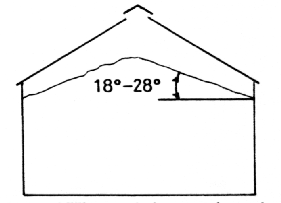
Peaking also makes it difficult and dangerous to enter the bin for observation. Because of dust and high temperatures during the summer, entering a small space between roof and grain should be prohibited. Shifting grain may block the exit.
If the grain is peaked during harvest, withdraw the peak immediately after harvest. Lowering the center core of the bin improves airflow through the center of the bin, and probing and sampling are made easier and safer. Some fines are also removed.
Broken grain and foreign material, or fines, can create two problems in stored grain, particularly when they accumulate in pockets. First, broken kernels are more susceptible to spoilage than unbroken ones. Second, airflow from aeration fans tends to go around pockets of fines so they cool more slowly. These pockets often develop into hot spots that result in spoiled grain.
Strive to minimize the fines produced from harvesting, drying, and handling, rather than later trying to solve resulting storage problems. Consider three grain storage management techniques that avoid problems from fines that do go into the storage:
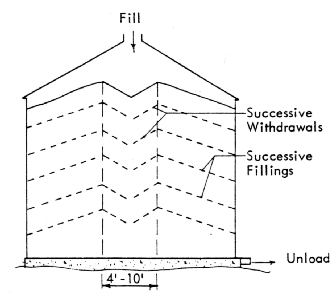
A secondary benefit of nondistributed filling is that the grain rolling down the cone of grain results in a looser fill than when using a grain distributor. This loose fill reduces the resistance to airflow through the grain. However, with nondistributed fines not removed by withdrawal, the aeration airflow patterns in the bin may not be uniform
Consider installing temperature sensing units in large grain storages. Fig 6 illustrates locating four cables with temperature sensors 4'-5' apart along each cable. Suspend the cables from the roof. Mount the center cable to one side of the center of the bin to reduce the drag on the cable when unloading grain. Check with the bin manufacturer to be sure the cables, supports and roof can withstand the drag from grain filling and unloading. Anchor the bottom of the cables to assure alignment but allow for a sweep unloader. Bring the circuits from the top of the cables to a central point for attaching to the read-out device.
Temperature sensors accurately trace the progress of aeration cooling or heating cycles. They help identify hot spots within the grain mass. They also indicate overall heating and approximate average grain temperature.
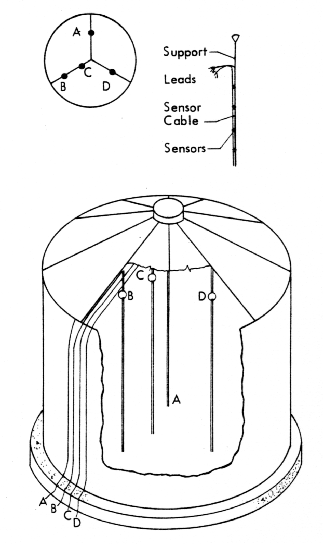
Four sensing cables are suspended from the roof: 3 are half way from wall to bin center, one is close to the center.
Temperatures may change only 1-2 F per week so read and record them accurately. A continual increase in temperature is a warning that must be heeded, especially if one spot in the bin is heating faster than the bin as a whole. Experience indicates that once heating starts, it continues to increase at an increasing rate until cooling is applied.
Insect infestations in storage can come from grain residues in combines, handling equipment, and old grain left in storage. Correctly drying, aerating and managing stored grain minimizes the risks of insect infestation and damage. Insect activity goes with moisture accumulation and grain heating. Whenever grain will be held during the warm part of the year, practice regular preventive treatment. Where infestations are more often found with poor quality grain, or where there is an occasional slip in overall management, emphasize observation and control. Look for insect activity during every storage visit. Follow this preharvest checklist:
For frequent insect problems, apply a grain protectant in addition to using a residual insecticide spray.
You have two alternatives for controlling a stored grain infestation:
Take time to review safety measures with workers and all family members. "Better safe than sorry" is very real around grain and hazardous machinery.
Absolutely forbid entry into a bin or gravity unload vehicle when grain is flowing. It is a major cause of accidental death when handling and unloading grain.
With modest flow rates of a 6" auger, you are helpless only two to four seconds after stepping into the cone of flowing grain. You are totally submerged within 20 seconds at a grain flow rate of only 1,000 bu/hr.
A child submerges even more quickly. Even in gravity-unload vehicles not as deep as the child's height, the massive outflow rate drags him down into the discharge cone, folding his legs and shortening the height necessary for complete submergence and suffocation.
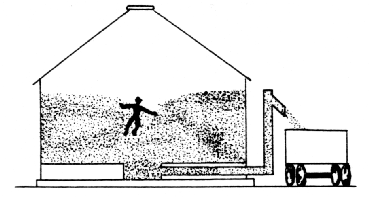
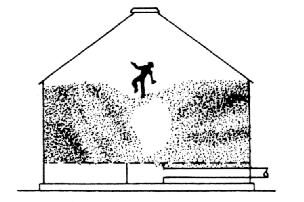
* Don't enter a bin of flowing grain.
* Don't enter a bin to break a crust or remove a blockage when unloading equipment is running, whether or not grain is flowing. Restarted flow can trap you.
* Before entering a bin or cleaning or repairing conveyors:
* Don't enter a bin unless you know the nature of previous grain removal, especially if any crusting is evident.
* Beware of walking on any surface crust.
* Don't depend on a second person--on the bin roof, on the ground, or at some remote point-to start or stop equipment on your shouted instructions.
* Be wary and alert while working with grain that has gone out of condition--there may be molds, blocked flow, cavities, cave-ins or crusting.
* When entering a questionable bin or storage, have two outside and one inside workers. Attach a safety rope to the man in the bin with the two men outside capable of lifting him out without entering the bin. One man outside cannot do this and cannot go for help while giving first aid.
* Always wear a respirator capable of filtering fine dust to work in obviously dusty-moldy grain. Never work in such conditions, even with protection, without a second person on safety standby.
* Parents, watch your children.
* If a grain bin is peaked close to the roof, be extremely cautious. Crawling between roof and peak can cave grain and block the exit.
* Maintain proper and effective shields and guards on hazardous equipment.
Observation Probable Cause Solution/Recommended Action
----------------------------------------------------------------------------------------------------------------------------------------------------------
Musty or spoiled grain odor. Heating, moisture accumulation in one spot. Run the fan. Smell the exhaust while in the bin or in front
of the exhaust fan. Run the fan to cool any hot spots. If
damage is severe, remove the grain.
Hard layer or core below grain High moisture or spoiled, caked grain mass. Run the aeration or drying fan. Check to see if caked or
surface. compacted mass blocks airflow. Cool and dry if airflow is
adequate, otherwise unload to remove all spoiled grain.
Warm grain below the top surface. Moisture content too high. Run the fan regardless of weather conditions until the exhaust
air temperature equals the desired grain temperature.
Surface grain wet or slimy. Perhaps Early signs of moisture migration, often Run aeration fan. Cool grain until exhaust temperatures equal
grain sticking or frozen together. noticeable only 1-2 weeks after binning. desired grain temperature or outside air temperatures.
Hard surface crust, caked, and Severe moisture migration and condensation in Remove the spoiled layer. Wear a dust mask to filter mold spores.
blocking airflow. Possibly strong the top surface. Run the fan to cool grain after spoilage is removed. Sample grain
enough to support a man. with probe to determine condition throughout center mass below
the crust. Consider marketing grain to arrest further spoilage.
Under-roof condensation dripping Warm grain in cold weather, severe convection Aerate until exhaust air temperature equals outdoor air
onto surface. circulation and moisture migration. temperature at beginning of aeration cycle.
Wet or spoiled spots on grain Condensate drip from bolt end or under roof Check grain for heating. Check roof under surface at night.
surface outside center point. fixture that funnels condensate flow; Check for caulking around roof inlets and joints.
possible roof leak.
Wet, spoiled spot directly under Leaking roof cap or condensed water from Check bin cap seal and hold down. Block or disconnect gravity
fill cap. gravity spout. spout so air from bin and grain cannot flow up tube. Marginal
solution: hang bucket under spout inlet and check bucket for
water accumulation.
No Air flow through grain with Moldy, caked grain mass blocking flow; Try to determine location and scope of spoilage. Unload storage
aeration fan running. possible moldy grain layer immediately above and market or re-bin good grain.
aeration duct or perforated floor
on suction system.
White dust visible whenever grain Mold on grain but not sufficient spoilage Wear dust mask in working grain. Evaluate grain condition
is stirred. to seal top surface. throughout bin where possible. Observe caution in continued
storage because grain condition has deteriorated to some degree.
Cooling time required much longer Increased fines in grain resisting and Run the fan longer time. Operate fan until grain and exhaust air
than usual. reducing airflow; increased fines can cause temperature readings indicate grain is at desired temperature,
airflow resistance to increase as much as regardless of the fan time required.
2-4 times over that of clean grain.
Exhaust air temperatures in center Fine material accumulation in storage center Run the fan sufficient time to cool the center irrespective of the
of bin surface warmer than those resisting airflow; airflow through center outside grain temperatures. Draw down the bin center to remove
away from center. mass grossly reduced compared to relatively fines and decrease the grain depth for easier air passage in the
clean grain around outside of storage. center core.
Unknown grain conditions in the Too deep to probe; bin too full to access; no Withdraw some grain from all bins to feed or market. Observe
bin center. temperature sensing cables installed. (look, feel, smell) first grain to flow with each withdrawal,
since it was in the center core. Withdraw any storage filled
above level full, as soon as possible following harvest, to
reduce moisture migration tendencies and permit access for
observation and sampling.
------------------------------------------------------------------------------------------------------------------------------------------------------------
RR 7/95
* Prepared by Bruce A. McKenzie extension agricultural engineer Purdue University: and Larry Van Fossen. extension agricultural engineer Iowa State University. The sections relating to insect control were prepared by David E. Foster and Harold J. Stockdale, Iowa State University extension entomologists.
Midwest Plan Service publications are available to all potential clientele without regard to race, color, sex, or national origin. Anyone who feels discriminated against should send a complaint within 180 days to the Secretary of Agriculture, Washington, DC 20250. We are an equal opportunity employer.